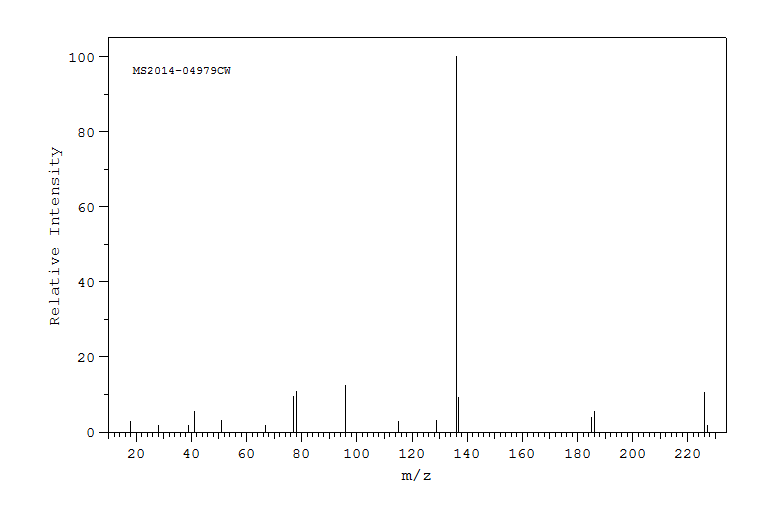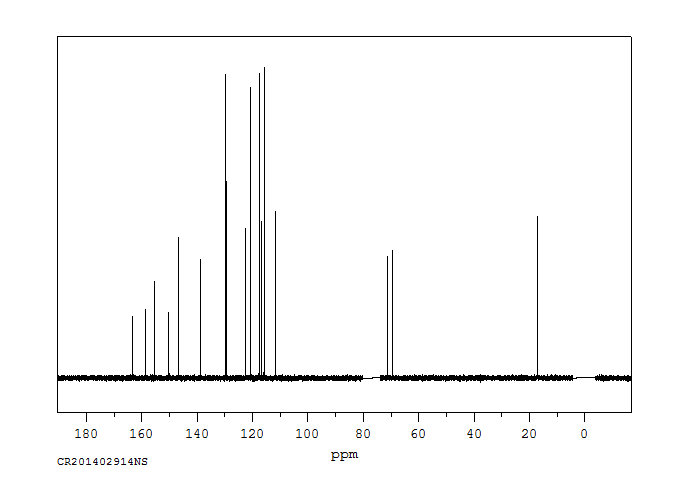吡丙醚 | 95737-68-1
-
物化性质
-
计算性质
-
ADMET
-
安全信息
-
SDS
-
制备方法与用途
-
上下游信息
-
文献信息
-
表征谱图
-
同类化合物
-
相关功能分类
-
相关结构分类
物化性质
-
熔点:45-47°C
-
沸点:230-250 °C(Press: 0.2 Torr)
-
密度:1.32
-
溶解度:DMF:30 mg/ml; DMF:PBS(pH7.2)(1:2):0.33mg/ml; DMSO:25 mg/ml;乙醇:15 mg/ml
-
LogP:4.840 (est)
-
物理描述:WHITE POWDER OR GRANULES
-
颜色/状态:Colorless crystals
-
味道:Faint odor (technical grade)
-
闪点:119 °C c.c.
-
蒸汽压力:<9.8X10-8 mm Hg at 23 °C
-
稳定性/保质期:
在常温常压下稳定,应避免与强氧化剂接触。
-
分解:Decomposes on burning. This produces toxic fumes including nitrogen oxides and carbon monoxide.
-
折光率:Index of refraction = 1.5832 at 20.5 °C/D
-
碰撞截面:182.76 Ų [M+H]+ [CCS Type: TW]
-
保留指数:2523.2
计算性质
-
辛醇/水分配系数(LogP):4.8
-
重原子数:24
-
可旋转键数:7
-
环数:3.0
-
sp3杂化的碳原子比例:0.15
-
拓扑面积:40.6
-
氢给体数:0
-
氢受体数:4
ADMET
安全信息
-
危险等级:9
-
危险品标志:N
-
安全说明:S60,S61
-
危险类别码:R50/53
-
WGK Germany:2
-
危险品运输编号:UN3077 9/PG 3
-
RTECS号:UT5804000
-
储存条件:密封储存,应存放在阴凉、干燥的库房中。
SDS
: 蚊蝇醚
产品名称
1.2 鉴别的其他方法
无数据资料
1.3 有关的确定了的物质或混合物的用途和建议不适合的用途
仅供科研用途,不作为药物、家庭备用药或其它用途。
模块 2. 危险性概述
2.1 GHS分类
急性毒性, 经皮 (类别5)
眼刺激 (类别2B)
急性水生毒性 (类别1)
2.2 GHS 标记要素,包括预防性的陈述
象形图
警示词 警告
危险申明
H313 接触皮肤可能有害。
H320 造成眼刺激。
H400 对水生生物毒性极大。
警告申明
预防
P264 操作后彻底清洁皮肤。
P273 避免释放到环境中。
措施
P305 + P351 + P338 如与眼睛接触,用水缓慢温和地冲洗几分钟。如戴隐形眼镜并可方便地取
出,取出隐形眼镜,然后继续冲洗.
P312 如感觉不适,呼救中毒控制中心或医生.
P337 + P313 如仍觉眼睛刺激:求医/就诊。 如仍觉眼睛刺激:求医/就诊.
P391 收集溢出物。
处理
P501 将内容物/ 容器处理到得到批准的废物处理厂。
2.3 其它危害物 - 无
模块 3. 成分/组成信息
3.1 物 质
: C20H19NO3
分子式
: 321.37 g/mol
分子量
组分 浓度或浓度范围
Pyriproxyfen
-
CAS 号 95737-68-1
EC-编号 429-800-1
模块 4. 急救措施
4.1 必要的急救措施描述
一般的建议
请教医生。 出示此安全技术说明书给到现场的医生看。
吸入
如果吸入,请将患者移到新鲜空气处。 如果停止了呼吸,给于人工呼吸。 请教医生。
皮肤接触
用肥皂和大量的水冲洗。 请教医生。
眼睛接触
用大量水彻底冲洗至少15分钟并请教医生。
食入
切勿给失去知觉者从嘴里喂食任何东西。 用水漱口。 请教医生。
4.2 主要症状和影响,急性和迟发效应
据我们所知,此化学,物理和毒性性质尚未经完整的研究。
4.3 及时的医疗处理和所需的特殊处理的说明和指示
无数据资料
模块 5. 消防措施
5.1 灭火介质
灭火方法及灭火剂
用水雾,耐醇泡沫,干粉或二氧化碳灭火。
5.2 源于此物质或混合物的特别的危害
碳氧化物, 氮氧化物
产品分解后性质不明
碳氧化物, 氮氧化物
5.3 给消防员的建议
如必要的话,戴自给式呼吸器去救火。
5.4 进一步信息
无数据资料
模块 6. 泄露应急处理
6.1 人员的预防,防护设备和紧急处理程序
使用个人防护设备。 防止粉尘的生成。 防止吸入蒸汽、气雾或气体。 保证充分的通风。
将人员撤离到安全区域。 避免吸入粉尘。
6.2 环境保护措施
在确保安全的前提下,采取措施防止进一步的泄漏或溢出。 不要让产物进入下水道。
防止排放到周围环境中。
6.3 抑制和清除溢出物的方法和材料
收集、处理泄漏物,不要产生灰尘。 扫掉和铲掉。 存放进适当的闭口容器中待处理。
6.4 参考其他部分
丢弃处理请参阅第13节。
模块 7. 操作处置与储存
7.1 安全操作的注意事项
避免接触皮肤和眼睛。 防止粉尘和气溶胶生成。
在有粉尘生成的地方,提供合适的排风设备。
7.2 安全储存的条件,包括任何不兼容性
贮存在阴凉处。 容器保持紧闭,储存在干燥通风处。
7.3 特定用途
无数据资料
模块 8. 接触控制和个体防护
8.1 容许浓度
最高容许浓度
没有已知的国家规定的暴露极限。
8.2 暴露控制
适当的技术控制
按照良好工业和安全规范操作。 休息前和工作结束时洗手。
个体防护设备
眼/面保护
带有防护边罩的安全眼镜符合 EN166要求请使用经官方标准如NIOSH (美国) 或 EN 166(欧盟)
检测与批准的设备防护眼部。
皮肤保护
戴手套取 手套在使用前必须受检查。
请使用合适的方法脱除手套(不要接触手套外部表面),避免任何皮肤部位接触此产品.
使用后请将被污染过的手套根据相关法律法规和有效的实验室规章程序谨慎处理. 请清洗并吹干双手
所选择的保护手套必须符合EU的89/686/EEC规定和从它衍生出来的EN 376标准。
身体保护
防渗透的衣服, 防护设备的类型必须根据特定工作场所中的危险物的浓度和含量来选择。
呼吸系统防护
如须暴露于有害环境中,请使用P95型(美国)或P1型(欧盟 英国
143)防微粒呼吸器。如需更高级别防护,请使用OV/AG/P99型(美国)或ABEK-P2型 (欧盟 英国 143)
防毒罐。
呼吸器使用经过测试并通过政府标准如NIOSH(US)或CEN(EU)的呼吸器和零件。
模块 9. 理化特性
9.1 基本的理化特性的信息
a) 外观与性状
形状: 凝结成块或碎片
b) 气味
无数据资料
c) 气味阈值
无数据资料
d) pH值
无数据资料
e) 熔点/凝固点
45 - 47 °C
f) 起始沸点和沸程
无数据资料
g) 闪点
无数据资料
h) 蒸发速率
无数据资料
i) 易燃性(固体,气体)
无数据资料
j) 高的/低的燃烧性或爆炸性限度 无数据资料
k) 蒸汽压
无数据资料
l) 蒸汽密度
无数据资料
m) 相对密度
1.230 g/cm3 在 20 °C
n) 水溶性
无数据资料
o) n-辛醇/水分配系数
无数据资料
p) 自燃温度
无数据资料
q) 分解温度
无数据资料
r) 粘度
无数据资料
模块 10. 稳定性和反应活性
10.1 反应性
无数据资料
10.2 稳定性
无数据资料
10.3 危险反应的可能性
无数据资料
10.4 应避免的条件
无数据资料
10.5 不兼容的材料
强氧化剂
10.6 危险的分解产物
其它分解产物 - 无数据资料
模块 11. 毒理学资料
11.1 毒理学影响的信息
急性毒性
半数致死剂量 (LD50) 经口 - 大鼠 - > 5,000 mg/kg
半数致死剂量 (LD50) 经皮 - 大鼠 - > 2,000 mg/kg
皮肤刺激或腐蚀
皮肤 - 兔子 - 无皮肤刺激
眼睛刺激或腐蚀
眼睛 - 兔子 - 轻度的眼睛刺激
呼吸道或皮肤过敏
无数据资料
生殖细胞突变性
无数据资料
致癌性
IARC:
此产品中没有大于或等于 0。1%含量的组分被 IARC鉴别为可能的或肯定的人类致癌物。
生殖毒性
无数据资料
特异性靶器官系统毒性(一次接触)
无数据资料
特异性靶器官系统毒性(反复接触)
无数据资料
吸入危险
无数据资料
潜在的健康影响
吸入 吸入可能有害。 可能引起呼吸道刺激。
摄入 如服入是有害的。
皮肤 如果通过皮肤吸收可能是有害的。 可能引起皮肤刺激。
眼睛 造成眼刺激。
接触后的征兆和症状
据我们所知,此化学,物理和毒性性质尚未经完整的研究。
附加说明
化学物质毒性作用登记: UT5804000
模块 12. 生态学资料
12.1 生态毒性
对鱼类的毒性 半数致死浓度(LC50) - Oncorhynchus mykiss (红鳟) - 0.45 mg/l - 96.0 h
对水蚤和其他水生无脊 半致死有效浓度(EC50) - Daphnia magna (大型蚤) - 0.4 mg/l - 48 h
椎动物的毒性
12.2 持久存留性和降解性
无数据资料
12.3 潜在的生物蓄积性
无数据资料
12.4 土壤中的迁移性
无数据资料
12.5 PBT 和 vPvB的结果评价
无数据资料
12.6 其它不利的影响
对水生生物毒性极大。
模块 13. 废弃处置
13.1 废物处理方法
产品
将剩余的和未回收的溶液交给处理公司。
与易燃溶剂相溶或者相混合,在备有燃烧后处理和洗刷作用的化学焚化炉中燃烧
受污染的容器和包装
作为未用过的产品弃置。
模块 14. 运输信息
14.1 联合国危险货物编号
欧洲陆运危规: 3077 国际海运危规: 3077 国际空运危规: 3077
14.2 联合国(UN)规定的名称
欧洲陆运危规: ENVIRONMENTALLY HAZARDOUS SUBSTANCE, SOLID, N.O.S. (Pyriproxyfen)
国际海运危规: ENVIRONMENTALLY HAZARDOUS SUBSTANCE, SOLID, N.O.S. (Pyriproxyfen)
国际空运危规: EnvironmeNTAlly hazardous subSTance, solid, n.o.s. (Pyriproxyfen)
14.3 运输危险类别
欧洲陆运危规: 9 国际海运危规: 9 国际空运危规: 9
14.4 包裹组
欧洲陆运危规: III 国际海运危规: III 国际空运危规: III
14.5 环境危险
欧洲陆运危规: 是 国际海运危规 海运污染物: 是 国际空运危规: 是
14.6 对使用者的特别提醒
进一步信息
危险品独立包装,液体5升以上或固体5公斤以上,每个独立包装外和独立内包装合并后的外包装上都必须有EHS
标识 (根据欧洲 ADR 法规 2.2.9.1.10, IMDG 法规 2.10.3),
模块 15 - 法规信息
N/A
模块16 - 其他信息
N/A
制备方法与用途
吡丙醚又称灭幼宝、蚊蝇醚,是一种新型昆虫生长调节剂。由日本住友化学工业株式会社研发成功,其作用类似于昆虫的保幼激素,能够抑制蚊、蝇幼虫化蛹和羽化。蚊、蝇幼虫接触该药剂后,大多在蛹期死亡,无法完成羽化过程。吡丙醚持效期可达1个月左右,并且使用方便,无异味,是一种较为理想的灭蚊、蝇药物。
防治对象吡丙醚是苯醚类昆虫生长调节剂,属保幼激素类似物的新型杀虫剂。具有内吸转移活性、低毒、持效期长、对作物安全、鱼类低毒、对生态环境影响小等特点。主要用于防治烟粉虱、介壳虫、小菜蛾、甜菜夜蛾、斜纹夜蛾、梨木虱、蓟马等害虫,同时也适用于防治苍蝇、蚊虫等卫生害虫,并可针对同翅目、缨翅目、双翅目、鳞翅目的害虫。该药物通过影响昆虫的蜕皮和繁殖来抑制其生长。
毒性按照我国农药毒性分级标准,吡丙醚属于低毒杀虫剂。原药大鼠急性经口LD50大于5000mg/kg体重,大鼠急性经皮LD50大于2000mg/kg体重,大鼠急性吸入LC50大于13000mg/m³(4小时)。对眼有轻微刺激作用,无致敏作用。在试验剂量下未见致突变、致畸反应。大鼠6个月喂养试验无作用剂量为400mg/kg体重,大鼠28天吸入试验无作用剂量为482mg/m³,动物吸收、分布、排出迅速。
使用方法吡丙醚用于防治蚊、蝇幼虫等卫生害虫。对于蚊子幼虫,每立方米用0.5%吡丙醚颗粒剂20g(有效成分100mg),直接投入水中(水深约10cm)。对于家蝇幼虫,则需在每立方米投放20~40g 0.5%吡丙醚颗粒剂(有效成分100~200mg)于孳生地表面。这些方法能有效地抑制蚊、蝇幼虫的生长。
注意事项- 应存放在避光、阴凉处,远离火源。
- 如药物触及皮肤,请用肥皂和清水彻底冲洗。
此外,大鼠急性经口LD50大于5000mg/kg,大鼠急性经皮LD50大于2000mg/kg。
化学性质纯品为结晶状物质,熔点在45~47℃之间。蒸气压约为0.29×10⁻³Pa(20℃),相对密度为1.23(20℃)。其溶解度如下:二甲苯中约50%,己烷中有40%,甲醇中约20%。
用途吡丙醚作为一种高效的苯醚类昆虫生长调节剂,主要用于防治同翅目、缨翅目、双翅目和鳞翅目的害虫。它通过抑制昆虫的蜕皮和繁殖来发挥其作用。对于蚊蝇这类卫生害虫而言,后期4龄幼虫使用低剂量本品即可导致化蛹阶段死亡,从而抑制成虫形成。施用时可将颗粒剂直接投入污水塘中或撒布于蚊蝇滋生地表面。
生产方法上下游信息
-
上游原料
中文名称 英文名称 CAS号 化学式 分子量 1-(4-苯氧基苯氧基)-2-丙醇 (R,S)-2-hydroxypropyl 4-phenoxyphenyl ether 57650-78-9 C15H16O3 244.29 -
下游产品
中文名称 英文名称 CAS号 化学式 分子量 —— 4-phenoxyphenyl 2-(2-pyridyloxy)propyl ether —— C20H19NO3 321.376 —— methylpyriproxyfen —— C21H21NO3 335.403 —— chloropyriproxyfen —— C20H18ClNO3 355.821 —— iodopyriproxyfen —— C20H18INO3 447.272 —— cyanopyriproxyfen —— C21H18N2O3 346.386 —— trifluoromethylthiopyriproxyfen —— C21H18F3NO3S 421.44 —— hexynylpyriproxyfen —— C26H27NO3 401.505 —— 2-((1-(4-(4-(4,4,5,5-tetramethyl-1,3,2-dioxaborolan-2-yl)phenoxy)phenoxy)propan-2-yl)oxy)pyridine —— C26H30BNO5 447.339
反应信息
-
作为反应物:描述:吡丙醚 在 吡啶 、 二氯双[二叔丁基-(4-二甲基氨基苯基)膦]钯(II) 、 三氟乙酸酐 、 zinc(II) iodide 、 锌 作用下, 以 N,N-二甲基甲酰胺 、 乙腈 为溶剂, 反应 13.0h, 生成 methylpyriproxyfen参考文献:名称:更正“通过两步芳基噻吩并还原烷基化序列对复杂芳烃进行位点选择性 C-H 烷基化”摘要:页面7912.在我们先前的通信中,我们无意中引起了与蚊蝇醚分子的不正确连接(蚊蝇醚的分子衍生的基片间的,而不是对被画),从化合物省略亚甲基13,并提请化合物的差向异构体20在方案 3。此处显示的更正方案 3 中已更正这些绘图错误。a一般条件,除非另有说明:芳基铪盐 (0.3 mmol)、烷基碘 (0.6 mmol)、PdCl 2 (amphos) 2 (15.0 μmol)、吡啶 (0.15 mmol)、DMF (0.3 M)。[a]>20:1 i- PrAr: n-PrAr 产品。[b]3.0 mmol 刻度。[c]吡啶被省略。[d] 以芳基铪盐 (0.2 mmol) 和 MgCl 2 (3 当量) 作为添加剂进行的反应。蓝色的产量对应于 C–H 硫蒽的产量。橙色的产率对应于芳基铪盐烷基化的产率。从参考文献 5b、6a、6b、6c、6d 和 6e 获得了硫蒽的产量。a一般条件,除非另有说明:芳基铪盐DOI:10.1021/jacs.1c06057
-
作为产物:描述:2-[1-[4-(3-Bromophenoxy)phenoxy]propan-2-yloxy]pyridine 生成 吡丙醚参考文献:名称:BOEHM, MARCUS F.;PRESTWICH, GLONN D., J. LABELL. COMPOUNDS AND RADIOPHARM., 25,(1988) N 9, 1007-1015摘要:DOI:
文献信息
-
[EN] ACC INHIBITORS AND USES THEREOF<br/>[FR] INHIBITEURS DE L'ACC ET UTILISATIONS ASSOCIÉES
-
[EN] BICYCLYL-SUBSTITUTED ISOTHIAZOLINE COMPOUNDS<br/>[FR] COMPOSÉS ISOTHIAZOLINE SUBSTITUÉS PAR UN BICYCLYLE申请人:BASF SE公开号:WO2014206910A1公开(公告)日:2014-12-31The present invention relates to bicyclyl-substituted isothiazoline compounds of formula (I) wherein the variables are as defined in the claims and description. The compounds are useful for combating or controlling invertebrate pests, in particular arthropod pests and nematodes. The invention also relates to a method for controlling invertebrate pests by using these compounds and to plant propagation material and to an agricultural and a veterinary composition comprising said compounds.本发明涉及公式(I)中变量如索权和说明中所定义的自行车基取代异噻唑啉化合物。这些化合物对抗或控制无脊椎动物害虫,特别是节肢动物害虫和线虫方面具有用途。该发明还涉及一种通过使用这些化合物来控制无脊椎动物害虫的方法,以及包含所述化合物的植物繁殖材料、农业和兽医组合物。
-
[EN] AZOLINE COMPOUNDS<br/>[FR] COMPOSÉS AZOLINE申请人:BASF SE公开号:WO2015128358A1公开(公告)日:2015-09-03The present invention relates to azoline compounds of formula (I) wherein A, B1, B2, B3, G1, G2, X1, R1, R3a, R3b, Rg1 and Rg2 are as defined in the claims and the description. The compounds are useful for combating or controlling invertebrate pests, in particular arthropod pests and nematodes. The invention also relates to a method for controlling invertebrate pests by using these compounds and to plant propagation material and to an agricultural and a veterinary composition comprising said compounds.本发明涉及式(I)的噁唑啉化合物,其中A、B1、B2、B3、G1、G2、X1、R1、R3a、R3b、Rg1和Rg2如权利要求和描述中所定义。这些化合物对抗或控制无脊椎动物害虫,特别是节肢动物害虫和线虫方面具有用途。该发明还涉及一种利用这些化合物控制无脊椎动物害虫的方法,以及包括所述化合物的植物繁殖材料、农业和兽医组合物。
-
[EN] MICROBIOCIDAL OXADIAZOLE DERIVATIVES<br/>[FR] DÉRIVÉS D'OXADIAZOLE MICROBIOCIDES申请人:SYNGENTA PARTICIPATIONS AG公开号:WO2017157962A1公开(公告)日:2017-09-21Compounds of the formula (I) wherein the substituents are as defined in claim 1, useful as a pesticides, especially fungicides.式(I)的化合物,其中取代基如权利要求1所定义,作为杀虫剂特别是杀菌剂有用。
-
Thieno-pyrimidine compounds having fungicidal activity
表征谱图
-
氢谱1HNMR
-
质谱MS
-
碳谱13CNMR
-
红外IR
-
拉曼Raman
-
峰位数据
-
峰位匹配
-
表征信息










